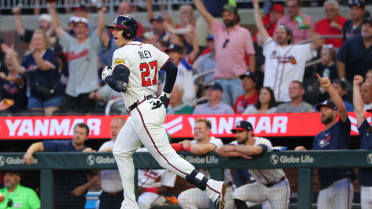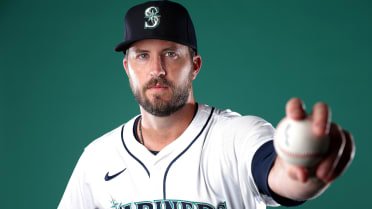WASHINGTON -- At long last, Jacob deGrom will return to the mound Tuesday at Nationals Park. It promises to be a significant event that the Mets, their fans and rival teams throughout baseball will watch with interest.
How exactly did we get here? It’s been a road strewn with obstacles for the two-time Cy Young Award winner, who hasn’t pitched since July 7, 2021, due to multiple injuries. Here's a primer on his situation.
What was the nature of deGrom’s injury?
He suffered a stress reaction in his scapula that was diagnosed at the end of March. Essentially, a stress reaction is an overuse injury, similar to a bone bruise. They take time to heal, because the only real way to do so is to rest them. deGrom believes his quick Spring Training ramp-up combined with a minor mechanical flaw caused this injury to his shoulder.
This is a different issue than what sidelined deGrom last year, when he missed the entire second half of the season because of an inflamed right elbow. At one point, president Sandy Alderson classified that injury as a partial tear of the ulnar collateral ligament, which deGrom disputed. In any case, his elbow has been a non-issue for the better part of a year.
Is he fully healthy now?
So the Mets say. And before you ask, there’s no way to know if this will last -- we’ll just have to wait and see.
Over the past three seasons, deGrom has frequently skipped or pushed back starts due to a string of back, lat, forearm, elbow and shoulder injuries. If he doesn’t miss any additional time, deGrom can still make up to 12 starts down the stretch, plus more in the playoffs. Mets officials harbor equal parts skepticism and optimism that he will do so.
What steps did deGrom need to take to reach this point?
It’s been a lengthy progression. For about a month after his diagnosis, deGrom was limited to strength-building and resistance exercises. He spent another month throwing off flat ground beginning in early May, before graduating to mound work with bullpen sessions and live batting practice. deGrom eventually began a Minor League rehab assignment on July 3, which was essentially the equivalent of his first Spring Training game. A minor bout of shoulder soreness during the All-Star break pushed back deGrom’s schedule one last time, but only by a few days.
His final rehab start was last Wednesday, putting deGrom on five full days of rest going into his debut.
How many pitches will he throw against the Nationals?
During that last rehab start, deGrom topped out at 67 pitches, which is the most he’s thrown in a game at any level since last July. The Mets will take things easy with him early this month, with pitching coach Jeremy Hefner estimating somewhere between four to six innings and 60-80 pitches on Tuesday. Mostly, it depends upon the stress level of his outing. Were there men on base? Did he have any long innings? That sort of thing.
Is he still throwing 100 mph? (And is that a good thing?)
For much of his rehab, deGrom was routinely hitting 100-101 mph on the radar gun, which is where he’s typically sat the past few years of his career. deGrom noticeably dialed that back in his final outing, which manager Buck Showalter said was due to cramping in his leg. deGrom painted a different picture, chalking the reduced velocity up to an intentional effort to take things easy as he tried to increase his workload.
Given the adrenaline of his season debut, deGrom figures to reach triple digits again on Tuesday. He and Mets officials have rebuffed the notion that a more permanent velocity reduction could help deGrom stay healthy, because they believe his elite figures stem from clean mechanics, not from overtraining or overthrowing.
Asked if he’ll hit 101 against the Nationals, deGrom grinned and replied: “We’ll see.”
How good can we expect him to be?
Probably pretty good. When healthy, deGrom has remained in a class of his own, with a 1.08 ERA over 15 starts before his injury last season. He finished third in National League Cy Young voting in 2020, after winning the award the previous two seasons. Since 2018, which is the point when he began setting new career highs in both fastball and slider velocity, deGrom owns a 1.94 ERA with 774 strikeouts in 581 innings.
In two outings this spring, deGrom allowed one run in five innings with 10 strikeouts. In four rehab starts, he produced a 2.84 ERA with 21 strikeouts in 12 2/3 innings (and most of that damage came in his final start). So long as deGrom stays healthy, there is no evidence to suggest he will be anything less than elite.
Said Hefner: “I have full expectation that we’re going to see a normal Jake.”
What does this mean for his contract situation?
Nothing, for now. deGrom remains under guaranteed contract through 2023, with a $32.5 million salary next year and a $32.5 million team option in ’24.
He has the ability to opt out of his deal after this season, which he has stated on multiple occasions he will do. He’s also said that his growing injury history won’t change that calculus. Financially speaking, opting out is the obvious move. If deGrom reestablishes his greatness from August through October, he should easily be able to clear $32.5 million in guaranteed money on the open market.
So he’s gone after October then?
Not necessarily. Oftentimes, opt-outs simply result in players renegotiating with their old teams. As a recent example, Clayton Kershaw used his opt-out clause as a way to strike a new deal with the Dodgers following the 2018 season. Stephen Strasburg did the same thing with the Nationals a year later.
deGrom has long stated his desire to remain a Met for life, but neither he nor the team has demonstrated much interest in negotiating until after this season. At any point, owner Steve Cohen could swoop in, offer deGrom a megadeal and put this whole business to rest. Or, Cohen could move in another direction, understanding the risk that deGrom represents as an expensive, 34-year-old asset with a long injury history.
At this point, it’s almost impossible to handicap deGrom’s chances of returning to the Mets. How he and the team fare down the stretch will be significant factors in what happens next.
Senior Reporter Anthony DiComo has covered the Mets for MLB.com since 2007.




